The Boeing C-17 Globemaster III military airlift aircraft is a high-wing, four-engine, T-tailed military transport vehicle capable of carrying payloads up to 169,000lb (76,657kg).
It has an international range and the ability to land on small airfields. A fully integrated electronic cockpit and advanced cargo system allows a crew of three (the pilot, co-pilot and loadmaster) to operate all systems on any type of mission.
In February 2009, a $2.95bn contract was awarded to Boeing to deliver 15 additional C-17s for the US Air Force. Two C-17s were delivered to the Stewart Air National Guard Base in July 2011.
Since it entered service in January 1995, 218 aircraft have been delivered to the US Air Force.
C-17 design features

A propulsive lift system allows the C-17 to achieve safe landings on short runways. The C-17 is capable of landing a full payload in less than 3,000ft. The propulsive lift system uses engine exhaust to generate lift.
The engine exhaust is directed onto large flaps, which extend into the exhaust stream, allowing the aircraft to fly a steep approach at a relatively low landing speed.
Auxiliary power unit

A Honeywell auxiliary power unit (APU) turbine is fitted in the front of the right main landing gear sponson to provide engine starting and ground power; a “ram air turbine” will be extended from the right sponson in the case of a comprehensive power failure, to provide hydraulic system power for minimal flight control. There are six fuel tanks in the wings, with a total capacity of 102,614 liters (27,108 US gallons), and an inflight refueling socket behind the cockpit. An inert-gas generation system helps reduce fuel system fires or explosions. In later production, at least some C-17s were fitted with a wing center-section tank with a capacity of 36,340 liters (9,600 US gallons) of fuel, these aircraft being informally designated as “C-17 ER”. It is unclear if the entire fleet has been kitted up to ER specification.
The nose landing gear has two wheels, while each of the two main gear assemblies has six wheels in two rows of three. The nose gear retracts forward and is steerable by rudder pedals, as well as a tiller for tight ground maneuvering. The main gear extends straight down from its sponsons; all landing gear assemblies will open by gravity in case of system failure. The landing gear can support steep-angle combat zone landings. Source airvectors.net
The aircraft is capable of turning in a small radius and can complete a 180° star turn in 80ft. The aircraft can also carry out routine backing. A fully loaded aircraft is capable of backing up a 2% gradient slope using the directed flow thrust reversers.
Cockpit of the C-17 Globemaster III
 Image @airteamimages.com
Image @airteamimages.com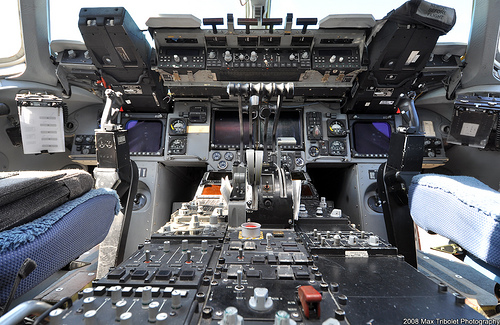
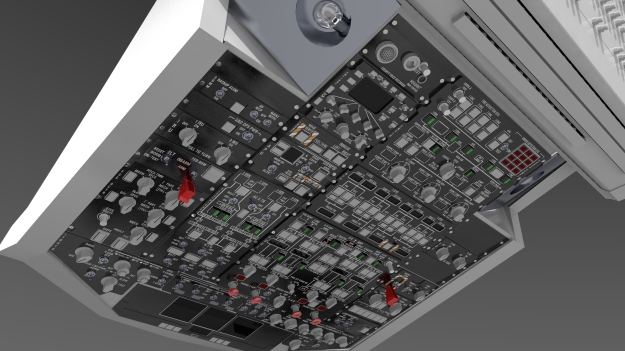 C-17 Overhead Panel – Image @robgraham.info
C-17 Overhead Panel – Image @robgraham.info
The C-17 cockpit accommodates pilot, co-pilot and two observer positions. The digital avionics system has four Honeywell multifunction cathode-ray tube displays, two full-capability HUDs (head-up displays) plus cargo systems.

The quadruple-redundant electronic flight control system also has a mechanically-actuated backup system.
CMC Electronics’ GPS Receiver Selected By BAE Systems
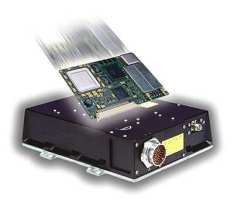
The CMC Electronics’ latest-generation, high-performance aviation Global Positioning System (GPS) receiver, known as the CMA-4124, has been selected by BAE Systems North America – Communications, Navigation, Information and Reconnaissance Division (BAE-CNI) – for integration into its Precision Landing System Receiver (PLSR). In turn, the PLSR has been selected by Boeing for the C-17 Globemaster III Avionics Upgrade Program. Source aero-news.net
IntegriFlight™ – SBAS CMA-4124 GNSSA Aviation Precision Approach GPS Receiver

- All hardware and software has been developed entirely at CMC Electronics, all aviation GPS receivers are manufactured at CMC Electronics. Full OEM customer support including certification.
- Software and firmware certified to DO-178B Level B and DO-254 Level B, designed to Level A
- Certified to TSO-C145c, Beta-3 and TSO-C146c, Delta-4.
- The SBAS CMA-4124 is available in several configurations, including SA-Aware only for specific non-SBAS applications.
Key Features
- 24 narrow correlator simultaneous channels, all of which can be used for simultaneous satellite tracking, up to 4 may be assigned as SBAS channels.
- Fault Detection and Exclusion (FDE), Integrity Monitoring, and automatic baro-altimeter incorporation as per DO-229D.
- Certified as single-string CAT-I Precision Approach system, provides ILS look-alike GS and LOC guidance LPV approach solution.
- Highly stable precision oscillator for maximum continuity of operation.
- Supports 9 ARINC inputs, 5 ARINC outputs, 4 RS-232/422 serial I/O, 16 discrete I/Os.
- Full temperature range from -55C to +75C.
- Comprehensive end-to-end receiver Built-in-Test (BIT).
- Designed for incorporation into all aviation systems such as Multi-Mode Receivers (MMRs), GPS Landing Systems (GLSs), Flight Management Systems (FMSs), from General Aviation to Air Transport.
- Outstanding MTBF and reliability.
- Growth path to GBAS including GBAS CAT-II/III.
- World-class customer support for all applications.
RECEIVER
Type 2 Active Antenna Ports with 2 GPS L1 RF channels, 24 parallel Narrow Correlator ® digital processing channels
Frequency L1, 1575.42 MHz, C/A code
Acquisition Sensitivity -134 dBm @ 32.87 dB Hz C/No
Tracking Sensitivity -134 dBm @ 31.04 dB Hz C/No
Time to First Fix < 75 seconds maximum, 95% confidence Hor.
Position Accuracy 15 meters, 95%, S/A off
Differential Better than 1.0 meters, 95%
Altitude Accuracy 20 meters, 95%, S/A off
Velocity Accuracy 0.5 knots, 95%, S/A off (0.33kts horizontal, 68 ft/min. vertical)
Position Update 10 independent solutions per seconds (10Hz solution rate)
SOFTWARE
Language Ada Level DO-178B
Level A design DO-178B, Level B certified
HARDWARE
Level DO-254 Level A Design DO-254 Level B Certified
Processor Pentium Equivalent
Source esterline.com & PDF File
There are two Lockheed Martin central processing computers, one Hamilton Sundstrand data management computer and two Honeywell air data computers.
A programme to upgrade the C-17A avionics includes new mission computers and displays, new software for the warning and caution system, provided by Northrop Grumman Navigation Systems. The automatic flight control system is upgraded with BAE Systems CsLEOS real-time operating system is certified for GATM (global air traffic management) system requirements.
APS-150/RDR-4000M Weather Radar
The Honeywell RDR-4000 is an advanced weather hazard and avoidance radar for both commercial and large military aircraft. Also known as IntuVue (for intuitive view), it is certified by the U.S. FAA for commercial use. The RDR-4000 collects a complete 3-D volumetric scan of the weather and terrain ahead of the aircraft, always showing the most reflective part of storm cells. The radar contains an internal worldwide terrain database, enabling it to extract ground clutter without the significant losses associated with ground suppression techniques. The data in the buffer continuously updates and compensates for aircraft movement.

The military version of the RDR-4000 radar is called the RDR-4000M, or APS-150. In addition to the weather, windshear, and turbulence detection features, the military radar provides a high-resolution ground map mode, a “skin paint” mode to better detect the returns from the skin of other aircraft, and a master cut-off switch for silent operations. The APS-150 equips USAF C-17 Globemasters, and sales will continue to support this platform. Another APS-150 platform is the Kawasaki C-2 tactical transport; Japan is looking to purchase 40-60 aircraft. In addition, EADS has chosen the APS-150 to equip its multinational A400M military transport. The A400M should be a major boost to APS-150 production. Source forecastinternational.com
 USAF C-17 – Image @strategypage.com
USAF C-17 – Image @strategypage.com
Cargo systems on Boeing’s C-17 Globemaster III
The design of the cargo compartment allows the C-17 to carry a wide range of vehicles, palleted cargo, paratroops, air-drop loads and aeromedical evacuees.
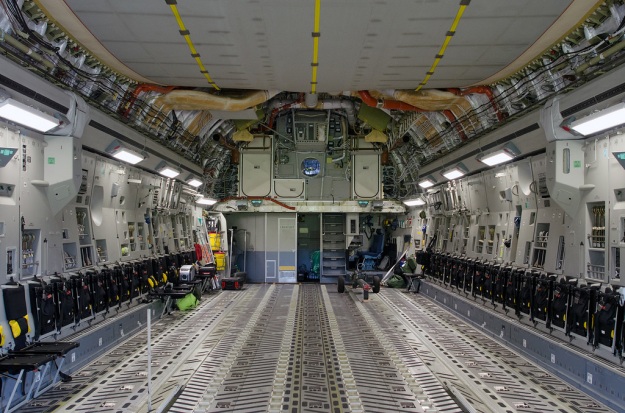
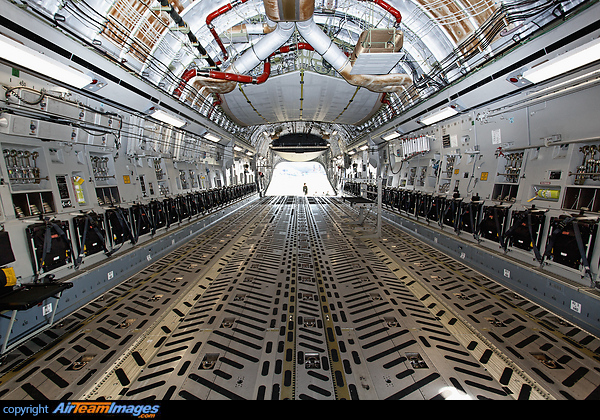 Image @airteamimages.com
Image @airteamimages.com Image @zimbio.com
Image @zimbio.com
The cargo compartment has a sufficiently large cross-section to transport large wheeled and tracked vehicles, tanks, helicopters (such as the AH-64 Apache), artillery and weapons such as the Patriot missile system. Three Bradley armoured vehicles comprise one deployment load on the C-17. The US Army M1A1 main battle tank can be carried with other vehicles.
 Boeing C-17 Globemaster III carrying an M1A1 tank with minesweeping outfit – Image @oddstuffmagazine.com
Boeing C-17 Globemaster III carrying an M1A1 tank with minesweeping outfit – Image @oddstuffmagazine.com
The maximum payload is 170,900lb (77,519kg) with 18 pallet positions, including four on the ramp. Airdrop capabilities include: a single load of up to 60,000lb (27,216kg), sequential loads of up to 110,000lb (49,895kg), Container Delivery System (CDS) airdrop up to 40 containers, 2,350lb (1,066kg) each, up to 102 paratroops.
 Image @defense.gov
Image @defense.gov
The transport aircraft is equipped for LAPES (low-altitude parachute extraction system) drops. For Medevac, the C-17 can transport up to 36 litter and 54 ambulatory patients and attendants. C-17s can take off from a 7,600ft airfield, fly 2,400nm and refuel while in flight. It can land on a 3,500ft-long (1,064m) and 90ft-wide (27.4m) airstrip.


The aircraft is operated by a crew of three (pilot, co-pilot and loadmaster), reducing both manpower requirements and operating costs. This cost-effective flight crew complement is made possible through the use of an advanced digital avionics system and advanced cargo systems. In the cargo compartment, the C-17 carries the Army’s wheeled vehicles in two side-by-side rows. For example, three combat-ready Stryker vehicles or 10 HMMWV (Humvees) comprise one deployment load. Also, the C-17 is able to transport the M1 Abrams main battle tank. Furthermore, the C-17 can carry up to 102 troops, 36 litter patients, or 18 standard 463-L pallets. Cargo and vehicles are loaded onto the C-17 through a large aft door that accommodates military vehicles and palletized cargo. The C-17 can carry virtually all of the Army’s air-transportable equipment. Source bga-aeroweb.com
463-L pallet

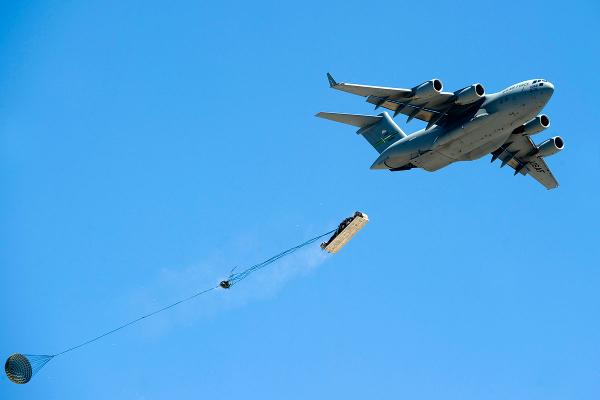 Image @military.com
Image @military.com
Countermeasure technology
The AN/AAR-47 has a suite of surface-mounted thermal sensors around the aircraft, which detect the thermal signature of the missile exhaust plume. Frequency selection and signal processing techniques are used to minimise the false alarm rate.
AN/AAR-47 missile warning system
The AN/AAR-47 Missile Warning System is a Missile Approach Warning system used on slow moving aircraft such as helicopters and military transport aircraft to notify the pilot of threats and to trigger the aircraft’s countermeasures systems. Its main users are the U.S Army, Navy and Air Force, but is also operated by other countries. Originally developed by Loral (now part of BAE Systems), it has been solely a product of Alliant Techsystems(ATK) since 2002.
The AN/AAR-47 passively detects missiles by their Ultraviolet signature, and uses algorithms to differentiate between incoming missiles and false alarms. Newer versions also have laser warning sensors and are capable of detecting a wider range of threats. After processing the nature of the threat, the system gives the pilot an audio and visual warning, and indicates the direction of the incoming threat. It also sends a signal to the aircraft’s infrared countermeasures system, which can then for example deploy flares.
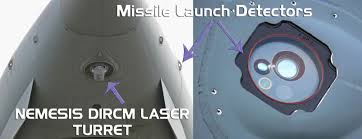
The AAR-47 missile warning system consists of 4 Optical Sensor Converters (OSC), a Computer Processor and a Control Indicator. The system is relatively light at a total weight of approximately 32 pounds.
There is one optical sensor converter for each side of the aircraft. They have an infrared camera for detecting incoming missiles. The Optical modules since version AAR-47(V)2 include a laser warning sensor, and versions since AAR-47A(V)2 further incorporate an ultraviolet sensor for improved dynamic blanking laser warning detection.
The computer processor evaluates the data from the OSC:s and analyzes whether a detected event is an incoming missile. If a threat is detected, it sends a signal to the control indicator which informs the crew, and the aircraft’s infrared countermeasures system. Source revolvy.com
The system provides a warning to the crew via the cockpit indicator unit of the presence and direction of the missile threat. A signal is automatically sent to the ALE-47 dispenser.
The AN/ALE-47 is capable of carrying a mix of expendable countermeasures, including jammers. The system interfaces to the C-17 aircraft’s sensors. The aircrew can select the mode of operation of the dispenser for fully automatic, semi-automatic or manual operation.
AN/ALE-47 countermeasures system
In response to automated warnings of radar, infrared, laser and other threats against aircraft, theAN/ALE-47 Countermeasures Dispenser System (CMDS) both assists the crew in staying aware of the threats, and managing the deployment of electronic warfare devices that operate externally to the vehicle. “Electronic”, in this context, covers enemy sensors across the electromagnetic spectrum. Electronic defense includes, as well as receivers and computers that detect and analyze threats, both countermeasures that are part of the aircraft, but also expendables that are released from it.
In other words, it both acts as an electronics countermeasures suite controller and as an electronic warfare expendables dispenser. It replaces the AN/ALE-39. Alternatively, it can be controlled by other control systems, such as the AN/ALQ-213. Source citizendium.org
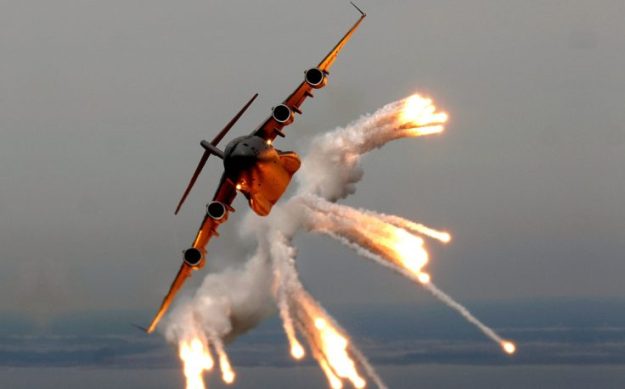 Image @wallup.net
Image @wallup.net
The cockpit control unit can be used to input mission data, together with the numbers and types of expendable countermeasures systems loaded into the ALE-47. The cockpit controller updates and displays the status of the dispenser and the numbers and types of countermeasures remaining.
The ALE-47 is capable of dispensing the new-generation active expendable decoys, POET and GEN-X, in addition to the conventional chaff and flare decoys that are compatible with the previous-generation ALE-40 and ALE-39 dispensers.
A total of 56 USAF C-17 aircraft are equipped with the Northrop Grumman large aircraft infra-red countermeasures (LAIRCM) system.
AN/AAQ-24(V) Nemesis
The AN/AAQ-24(V) Directional Infrared Countermeasure (DIRCM) system is the only DIRCM system in production today that will protect aircraft from today’s infrared guided missiles.
Traditional IR countermeasures are not effective against the modern IR missiles that are growing in popularity among terrorist groups and in thirdworld countries. A Directional Infrared Countermeasures (DIRCM) system is required to defeat the latest and future advanced IR threats, and has a lower life cycle cost compared to other IR countermeasure approaches.
- Simultaneously tracks and defeats threats in clutter environments
- Fast, accurate threat detection and simultaneous jamming in all current IR threat Bands (I, II and IV)
- Counters all fielded IR missile threats using a single generic jam waveform
- Complete end-to-end self-testing features reduce life-cycle maintenance
- Compatible with existing support facilities
Customized installation
The AAQ-24(V) is available in a laser-based configuration. Northrop Grumman then selects from a modular family of transmitters, jammers and missile warning systems to provide a customized installation best able to meet your specific platform, mission and budget requirements. Upgrades to existing systems are easy to install without further airframe modifications.
Source northropgrumman.com
LAIRCM is based on the AN/AAQ-24(V) Nemesis. It entered low-rate initial production in August 2002 and completed initial operational test and evaluation in July 2004. 25 upgraded aircraft have been delivered. The system entered service in 2007. The four aircraft leased by the UK Royal Air Force (RAF) are fitted with LAIRCM.
Turbofan engines of the transport aircraft
 Pratt & Whitney PW2040 (military designation-F117-PW-100) turbofan engine – Image @xairforces.net
Pratt & Whitney PW2040 (military designation-F117-PW-100) turbofan engine – Image @xairforces.net Pratt & Whitney PW2040 (military designation-F117-PW-100) turbofan engine – Image @airteamimages.com
Pratt & Whitney PW2040 (military designation-F117-PW-100) turbofan engine – Image @airteamimages.com
The four Pratt & Whitney PW2040 (military designation-F117-PW-100) turbofan engines with 40,440lb thrust each are integrated in the wings. Engine thrust reversers, which are operable in flight, and speed brakes enable the aircraft to carry out rapid deceleration and descent manoeuvres.
The Pratt & Whitney F117-PW-100 two-spool high-bypass turbofan engine is the military version of the commercial PW2040 engine used on the Boeing 757. The F117 features a Full-Authority Digital Engine Control (FADEC) system, which provides higher operational performance, lower fuel burn and advanced maintenance diagnostics.
The F117 was selected by the U.S. Air Force as the exclusive power plant for the C-17 Globemaster III military transport aircraft. The Boeing C–17 Globemaster III is a four-engine widebody aircraft capable of airlifting outsized and oversized payloads over intercontinental ranges with or without in-flight refueling. Its capabilities include rapid direct delivery of forces by air, land or airdrop into difficult tactical environments with runways as short as 3,000 feet. On the C-17, each of the four F117 engines produces 40,440 pounds of thrust.
Unique to the C-17, the F117 engines are equipped with a directed-flow thrust reverser capable of being deployed in flight. On the ground, the thrust reverser can back a fully loaded aircraft up a two-degree slope.
The F117 first entered service in 1993. To date, F117 engines have accumulated more than 12 million flight operating hours in support of military and humanitarian missions around the world. With 12+ million hours of military service and 50 million hours in commercial use, the F117/PW2040 has proven itself as a highly dependable engine. In January 2016, the 1,313th and final production engine was delivered to the U.S. Air Force. The F117 was built at Pratt & Whitney’s Engine Center in Middletown, Connecticut.
The F117 engine can remain on-wing for up to eight years between servicing visits. Recently, the F117 exceeded 9,000 hours in mean time between removal. This lowers MRO costs and provides outstanding mission readiness for C-17 operators. Source fi-powerweb.com
Pratt & Whitney PW2040 (military designation-F117-PW-100) turbofan engine
Manufacturer: Pratt & Whitney (United Technologies)
Thrust: 40,440 pounds
Overall Pressure Ratio at Maximum Power: 30.8
Thrust-to-Weight Ratio: 5.7
Bypass Ratio: 5.9
Compressor: Two-spool, axial flow, single-stage fan
LP-HP Compressor Stages: 4-12
HP-LP Turbine Stages: 2-5
Combustor Type: Annular
Engine Control: FADEC
Length: 146.8 in (3.73 m)
Diameter: 84.5 in (2.15 m)
Dry Weight: 7,100 lbs (3,220 kg)
Platforms: C-17 Globemaster III
Price/Unit Cost: $9.75 million (in 2012)
First Run: Unknown
First Flight: September 15, 1991
Source fi-powerweb.com
 Pratt & Whitney PW2040 (military designation-F117-PW-100) turbofan engine
Pratt & Whitney PW2040 (military designation-F117-PW-100) turbofan engine
The cruise speed is between Mach 0.74 and 0.77. The range without in-flight refuelling, and with a payload of 160,000lb, is 2,400nm. Aerial refuelling provides an intercontinental non-stop range.
Fuel control panel
Performance
- Cruise speed: Mach 0.74 (450 knots, 515 mph (829 km/h))
- Range: 2,420 nmi (2,785 mi (4,482 km)) ; 5,610 nmi (10,390 km) with paratroopers
- Service ceiling: 45,000 ft (13,716 m)
- Max. wing loading: 150 lb/ft² (750 kg/m²)
- Minimum thrust/weight: 0.277
- Takeoff run at MTOW: 7,600 ft (2,300 m)
- Landing distance: 3,500 ft (1,100 m)
Source wikiwand.com

OVER THE PACIFIC — A C-17 Globemaster III approaches a KC-135 Stratotanker to practice air-to-air refueling during a local training mission June 21. The C-17 is on loan to the 15th Airlift Wing at Hickam Air Force Base, Hawaii, from the 437th AW at Charleston AFB, S.C. The KC-135 is assigned to the Hawaii Air National Guard’s 203rd Air Refueling Squadron. (U.S. Air Force photo by Tech. Sgt. Shane A. Cuomo)
End of an Era for Boeing’s C-17: Here
Price/Unit Cost:
In 2012, the unit cost of a C-17 was $225 million. The airframe cost $178.56 million, the four F117-PW-100 engines cost $39 million ($9.75 million each), and the avionics cost $7.44 million.
Mission/Role:
The C-17 provides outsize intra-theater airland/airdrop capability not available in the current airlift force. The aircraft provides rapid strategic delivery of troops and all types of cargo to main operating bases or directly to forward bases in the deployment area.
Source bga-aeroweb.com
C-17 Globemaster international orders
The C-17 fleet of UK Royal Air Force have flown more than 100,000 flight hours, as of March 2015.
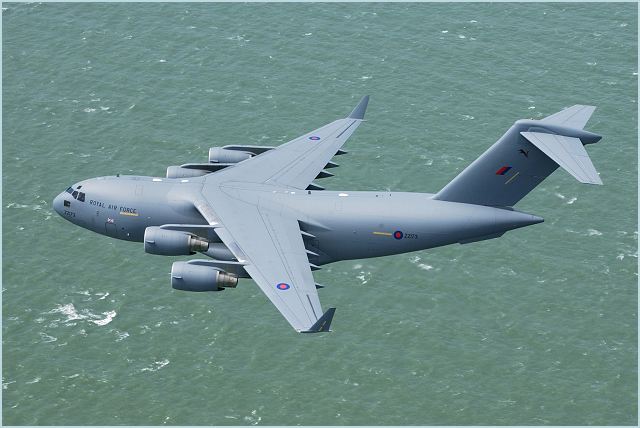 RAF C-17 – Image @armyrecognition.com
RAF C-17 – Image @armyrecognition.com
In August 2006, a fifth aircraft (delivered in April 2008) was ordered and the purchase of the first four aircraft in 2008 was confirmed. In December 2007, the UK purchased a sixth aircraft, which was delivered in June 2008. Boeing delivered the seventh aircraft in November 2010. The eighth aircraft was delivered to the UK Royal Air Force in May 2012.
In March 2006, Australia selected the C-17, with a requirement for four aircraft. The first aircraft was delivered in December 2006, the second in May 2007, the third in February 2008 and the final aircraft in March 2008.
Australia signed a foreign military sale (FMS) agreement with the US Government in April 2011 to procure the fifth C-17 for the Royal Australian Air Force (RAAF). It was delivered in September 2011. An order for the sixth C-17 was placed in 2011 and the same was delivered in November 2012. Australia ordered two more aircraft in April 2015 and took delivery of the seventh in July 2015 and the eighth aircraft in November 2015.

Air Force personnel direct an M1A1 Abrams onto the loading ramp of a Royal Australian Air Force (RAAF) C-17A Globemaster III aircraft at RAAF base Darwin.For the first time, an Army M1A1 Abrams tank has been flown on board a Royal Australian Air Force (RAAF) C-17A Globemaster III transport.On May the 11th, the C-17A carried the Abrams from RAAF Base Darwin to the Capricornia region as part of Exercise Hamel, where it will participate with other Defence units in the Shoalwater Bay Field Training Area.The Abrams is carefully driven up the cargo ramp of the C-17A and restrained to the cargo floor in a precise position, allowing the aircraft to remain balanced in flight.The flight of the Abrams provides vital experience for Army and Air Force personnel, emphasises a key joint strategic capability for Defence.
In July 2006, Canada announced the selection of the C-17 with a requirement for four aircraft. The contract was signed in February 2007. Deliveries began in August 2007 and concluded in April 2008. An additional C-17, ordered by Canada in 2014, was delivered in March 2015.
In September 2006, Nato announced its intention to buy an initial three or four C-17 aircraft. In June 2007, an international consortium, consisting of 15 Nato countries plus two partner countries (Finland and Sweden), agreed to set up the strategic airlift capability (SAC) at Papa Air Base in Hungary.
The Nato Airlift Management Organisation (Namo) purchases, owns and manages the aircraft. A multinational military unit, the heavy airlift wing (HAW), conducts airlift operations.
In May 2008, SAC requested the foreign military sale of the first two C-17 aircraft. The first C-17 was delivered to the SAC in July 2009. The second and third C-17s were delivered in September 2009 and October 2009 respectively. The SAC1 C-17’s first flight was completed in June 2009.
In March 2007, Boeing announced C-17 production would conclude in 2009, when current orders have been fulfilled. However the purchase of 15 additional aircraft for the USAF was approved in 2008.
In July 2008, Qatar placed an order for two C-17s with an option for an additional two units. The first aircraft was delivered in August 2009, and the second in September 2009. Qatar received the third and fourth aircraft in 2012. An order for four more aircraft was placed in June 2015.
 The Qatar Emiri Air Force is doubling its fleet of Boeing C-17A Globemaster IIIs. An agreement was signed at the Paris Air Show (PAS15) on 15 June 2015 for a second batch of four of these strategic airlifters.
The Qatar Emiri Air Force is doubling its fleet of Boeing C-17A Globemaster IIIs. An agreement was signed at the Paris Air Show (PAS15) on 15 June 2015 for a second batch of four of these strategic airlifters.
 Featured image: The second Qatar Emiri Air Force C-17A Globemaster III (Image © Boeing)
Featured image: The second Qatar Emiri Air Force C-17A Globemaster III (Image © Boeing)
Qatar was the first Middle East customer to order C-17s. Two C-17s were received in 2009, with a second two arriving in 2012. One of the C-17s is operated as a VIP airline for the royal family and the government of Qatar. This Qatar Globemaster flies in the livery of Qatar Airways, like many of the Qatar Amiri Flight. Source airheadsfly.com
The UAE announced in February 2009 that it would acquire four C-17s. The emirates ordered a total of six C-17s in January 2010. The first C-17 was delivered to the UAE in May 2011 and the second in June 2011. The third C-17 was delivered in July 2011. The last aircraft was delivered in June 2012.
The Indian Ministry of Defence signed a $4.1bn agreement with Boeing in June 2011 to acquire ten C-17 airlifters. US Congress authorised the FMS in May 2010. The C-17 met all the Indian Air Force’s requirements during rigorous field evaluation trials held in India in June 2010. Boeing delivered the first C-17 to the Indian Air Force (IAF) in June 2013 and four more by November 2013. The remaining five were delivered in 2014. Kuwait received two C-17s in 2014.
Boeing Steers Clear of Compliance With $4.1 Bln Indian Air Force Deal: Deal
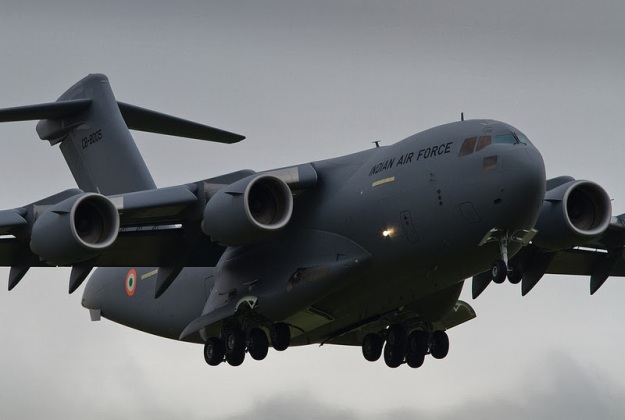 IAF C-17 – Image @globalmilitaryreview.blogspot.com
IAF C-17 – Image @globalmilitaryreview.blogspot.com
U.S. has approved the possible sale to India of one Boeing C-17 transport aircraft: Here
Excerpt
The U.S. State Department has approved the possible sale to India of one Boeing C-17 transport aircraft, with an estimated cost of $366 million, a Pentagon agency said on Monday.
India to receive final ‘white-tail’ C-17: Here
Excerpt
The announcement on 26 June that India is to receive another Boeing C-17 Globemaster III strategic airlifter has brought to an end a two-year effort to sign up a customer for the last aircraft to roll off the now-closed production line at Long Beach, California.
The US Defense Security and Cooperation Agency (DSCA) said that the State Department has approved the sale to India of the final C-17 for USD336.2 million. The proposed deal, which still needs to be approved by Congress, covers equipment as well as sustainment and support in addition to the aircraft. The Indian Air Force (IAF) already fields 10 C-17s that are flown by 81 Squadron out of Hindon Air Force Station, near Delhi.
Flight-testing of the C-17 using a blend of synthetic fuel and JP-8 began in October 2007, as part of a USAF process to develop more-efficient fuel for its fleet, with less reliance on imported petrol. Certification for the aircraft powered by synthetic fuel was completed in February 2008.
Boeing has 700 suppliers in 44 states.
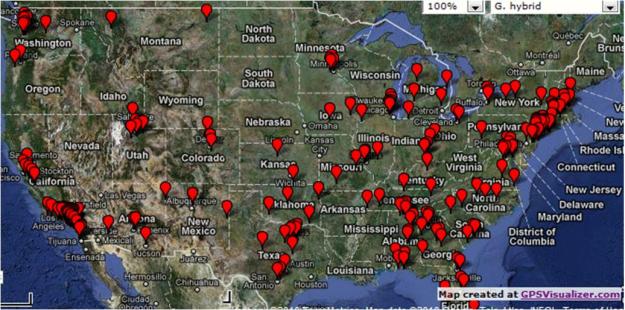 Map: Geographic Distribution of C-17 Subcontractors – Image @budgetinsight.wordpress.com
Map: Geographic Distribution of C-17 Subcontractors – Image @budgetinsight.wordpress.com
Unlike many other programs,taxpayers have a detailed glimpse into its supply chain, which now includes 268 firms spread across 219 cities in 36 states. The 10 aircraft included in the Pentagon’s FY10 budget will distribute $2.5 billion among these firms (pg. 16). Each is a valued part of some Congress member’s district and, seemingly not by coincidence, they are located our country’s most populous areas. Only 8% of Americans live in the 28% of states (14 out of 50) unrepresented in the C-17 supply chain (est. 07/2009). Source budgetinsight.wordpress.com
Main material source airforce-technology.com
Updated Oct 06, 2017
General Characteristics
Primary Function: Cargo and troop transport
Prime Contractor: Boeing Company
Power Plant: Four Pratt & Whitney F117-PW-100 turbofan engines
Thrust: 40,440 pounds, each engine
Wingspan: 169 feet 10 inches (to winglet tips) (51.75 meters)
Length: 174 feet (53 meters)
Height: 55 feet 1 inch (16.79 meters)
Cargo Compartment: length, 88 feet (26.82 meters); width, 18 feet (5.48 meters); height, 12 feet 4 inches (3.76 meters)
Speed: 450 knots at 28,000 feet (8,534 meters) (Mach .74)
Service Ceiling: 45,000 feet at cruising speed (13,716 meters)
Range: Global with in-flight refueling
Crew: Three (two pilots and one loadmaster)
Aeromedical Evacuation Crew: A basic crew of five (two flight nurses and three medical technicians) is added for aeromedical evacuation missions. Medical crew may be altered as required by the needs of patients
Maximum Peacetime Takeoff Weight: 585,000 pounds (265,352 kilograms)
Load: 102 troops/paratroops; 36 litter and 54 ambulatory patients and attendants; 170,900 pounds (77,519 kilograms) of cargo (18 pallet positions)
Unit Cost: $202.3 million (fiscal 1998 constant dollars)
Date Deployed: June 1993
Inventory: Active duty, 187; Air National Guard, 12; Air Force Reserve, 14
Source af.mil









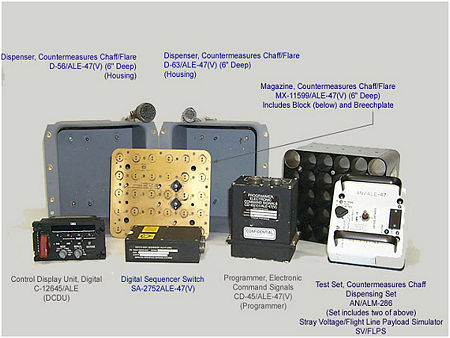

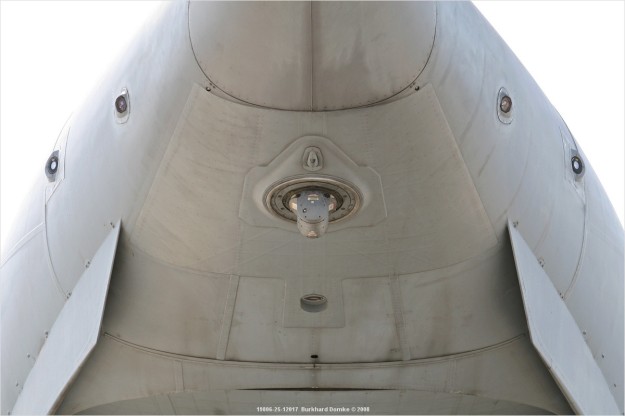

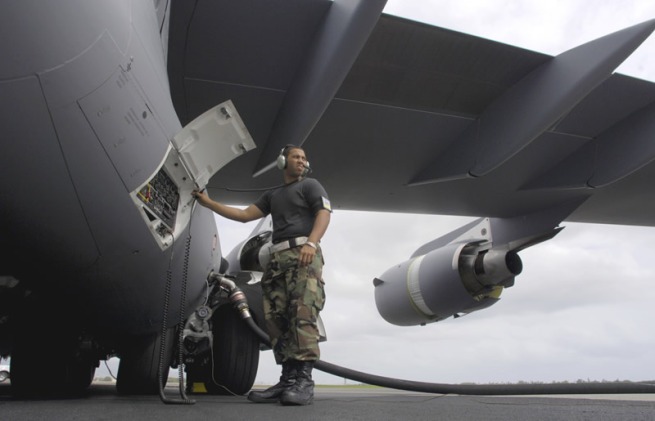

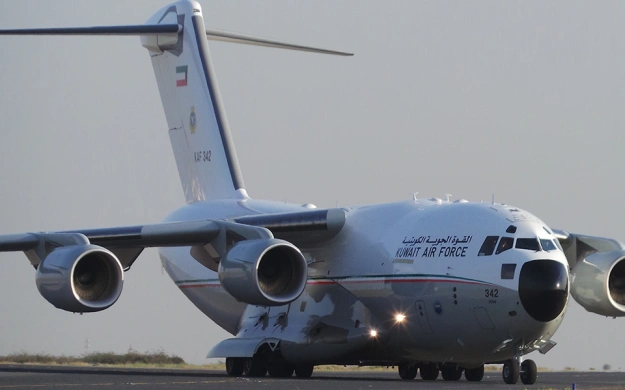
Pingback: C-17 Globemaster III Tactical Transport Aircraft — Thai Military and Asian Region | Mechanical Turk Ahmed Karamanoglu